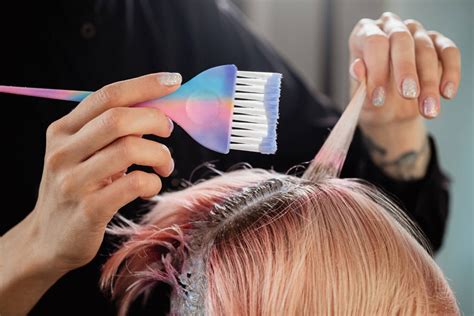Introduction

Synthetic hair dye has revolutionized the way individuals express their individuality through hair color. With its vibrant hues and endless possibilities, it empowers countless people to transform their appearance and boost their confidence. This article delves into the fascinating world of synthetic hair dye, exploring its types, benefits, safety considerations, and the latest trends.
Types of Synthetic Hair Dyes
1. Permanent Hair Dyes:
– Bond to the hair’s natural pigments, permanently altering the hair color.
– Require professional application due to their complex chemical composition.
2. Semi-Permanent Hair Dyes:
– Last for up to 28 washes.
– Deposit color on the hair’s surface, gradually fading over time.
– Available in a wide range of colors and can be applied at home.
3. Demi-Permanent Hair Dyes:
– Last for up to 12 washes, providing subtle color changes.
– Contain weaker pigments than permanent dyes and gently enhance natural hair tones.
4. Temporary Hair Dyes:
– Wash out after a few shampoos.
– Ideal for experimenting with new colors or adding temporary accents.
Benefits of Synthetic Hair Dye
1. Color Customization:
– Offers a vast spectrum of colors, allowing individuals to achieve their desired looks.
– Enables personalized hair color solutions to suit different skin tones and styles.
2. Coverage of Gray Hair:
– Effectively conceals gray or white hair, restoring youthful appearance.
3. Damage Repair:
– Some synthetic hair dyes contain conditioning agents that repair damaged hair and improve its health.
Safety Considerations
1. Allergy Testing:
– Before using any hair dye, perform a patch test to ensure no allergic reactions.
2. Chemical Exposure:
– Permanent hair dyes contain harsh chemicals that can irritate scalp and damage hair structure.
3. Protective Gear:
– Wear gloves and a mask during hair dyeing to minimize skin and respiratory exposure to chemicals.
Latest Trends
1. Vivid Hues:
– Bold and vibrant colors, such as electric blues, emerald greens, and fiery reds, are gaining popularity.
2. Pastel Dreams:
– Soft and ethereal pastel shades, like lavender, mint, and peach, offer a touch of delicate color.
3. Ombre and Balayage:
– Gradient color techniques that create seamless transitions from dark roots to lighter tips.
Innovation in Synthetic Hair Dye
“Chromify”: A wearable device that uses LED lights to temporarily change hair color without chemicals.
Pain Points and Motivations
Pain Points:
- Chemical damage and scalp irritation.
- High cost of professional dyeing.
- Limited color options for natural hair tones.
Motivations:
- Desire for self-expression and style enhancement.
- Covering gray hair to maintain a youthful appearance.
- Correction of unwanted hair colors.
Effective Strategies for Problem-Solving
1. Research Products Thoroughly:
– Study ingredients, safety precautions, and reviews to find suitable hair dyes.
2. Choose Reputable Brands:
– Opt for products from trusted manufacturers with proven track records.
3. Consult a Hair Stylist:
– Seek guidance from a professional hair stylist for personalized color recommendations and application techniques.
4. Follow Instructions Carefully:
– Adhere to the manufacturer’s instructions for proper use and minimize potential damage.
Pros and Cons of Synthetic Hair Dye
Pros:
- Color customization and gray hair coverage.
- Improved appearance and confidence.
- Wide range of options and availability.
Cons:
- Potential chemical damage and scalp irritation.
- Fading and color maintenance.
- Time and cost involved in professional application.
Conclusion
Synthetic hair dye has become an essential tool for expressing individuality and enhancing one’s appearance. With its wide range of types, benefits, and safety considerations, it empowers individuals to color their hair in vibrant and creative ways. By staying informed about the latest trends and innovations, understanding potential pain points and motivations, and adopting effective problem-solving strategies, everyone can harness the transformative power of synthetic hair dye to achieve their desired hair color goals.
FAQs
Q: Can synthetic hair dye damage my hair?
A: Yes, permanent hair dyes can damage hair structure due to their harsh chemicals.
Q: How often can I dye my hair with synthetic dyes?
A: The frequency depends on the type of dye and your hair’s condition. Consult a hair stylist for personalized recommendations.
Q: Is synthetic hair dye safe for pregnant or breastfeeding women?
A: Some studies suggest avoiding permanent hair dyes during pregnancy and breastfeeding due to potential chemical exposure.
Tables
Table 1: Types of Synthetic Hair Dye
| Dye Type | Duration | Application |
|---|---|---|
| Permanent | Indefinite | Professional |
| Semi-Permanent | Up to 28 washes | Home or professional |
| Demi-Permanent | Up to 12 washes | Home or professional |
| Temporary | A few shampoos | Home |
Table 2: Benefits of Synthetic Hair Dye
| Benefit | Description |
|---|---|
| Color Customization | Endless possibilities for personalized hair colors |
| Gray Hair Coverage | Conceals gray or white hair for a youthful look |
| Damage Repair | Some dyes contain conditioning agents to improve hair health |
Table 3: Safety Considerations for Synthetic Hair Dye
| Consideration | Precaution |
|---|---|
| Allergy Testing | Patch test before use |
| Chemical Exposure | Wear protective gear during hair dyeing |
| Skin Irritation | Seek medical attention if irritation occurs |
Table 4: Pros and Cons of Synthetic Hair Dye
| Pros | Cons |
|---|---|
| Color customization and gray hair coverage | Potential chemical damage and scalp irritation |
| Improved appearance and confidence | Fading and color maintenance |
| Wide range of options and availability | Time and cost involved in professional application |
